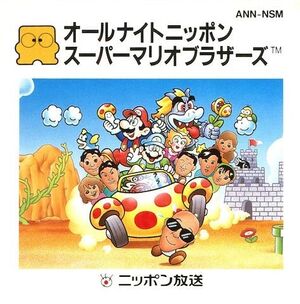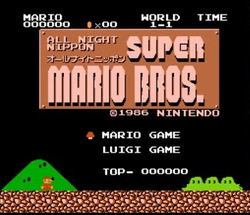All Night Nippon Super Mario Bros.

| |
| All Night Nippon Super Mario Bros. | |
| Developer | Nintendo R&D4 |
|---|---|
| Publisher | Fuji Television |
| Platforms | FDS |
| Released | 1986 |
| Added to Museum |
Fan translation: April 17, 2020 FDS: December 12, 2022 |
All Night Nippon Super Mario Bros. (オールナイトニッポン スーパーマリオブラザーズ) was a game in the Super Mario series. It was an officially licensed version of Super Mario Bros. that was awarded as a raffle prize on the Nippon Broadcasting System's “All Night Nippon” radio show in 1986.
Story
Peach has become the princess of the Viva Kingdom. Unfortunately, King Koopa discovers this. He sends his minions out to conquer the Viva Kingdom and kidnaps Peach once again. Now Mario, or optionally his brother Luigi, travels across eight different worlds within the kingdom, and collects power-ups to defeat enemies standing in the way.
The first seven worlds have a castle where an enemy is disguised as King Koopa, and beating them reveals their true nature. Then, upon reaching the dungeon, Mario rescues one of the many Japanese celebrities in the Viva Kingdom, who lets Mario know that the princess is in another castle.
Finally, upon defeating King Koopa at the castle in the eighth world, Princess Peach is finally rescued. The Japanese celebrities appear and cheer the rescue of the Viva Kingdom's new princess. If the princess is rescued eight times, access will granted to enter four more worlds. At the end of the fourth of the newly-accessed world, Peach is once again rescued from King Koopa.
Development
Prior to the development of the game, All Night Nippon already had a relationship with Nintendo in regards to Super Mario Bros. In 1985, on an All Night Nippon show hosted by Takao Komine, listeners were instructed to send in their own lyrics for the Super Mario Bros. theme song. The winning entry, Go Go Mario!!, was released on an album officially licensed by Nintendo, and was later available at Karaoke bars in Japan.
1987 was the 20th anniversary of All Night Nippon. They commissioned a version of Super Mario Bros. with All Night Nippon celebrities to celebrate, and held a raffle in December 1986 to give 3,000 disks containing the game away.
Changes from Super Mario Bros.
World changes:
- World 1-1, takes place at night. This change also affects the title screen and demonstration.
- World 1-4 contains the Japanese celebrity Miyuki Nakajima, rather than the usual mushroom retainer.
- World 2-4 contains the Japanese celebrity Takaaki Ishibashi, rather than the usual mushroom retainer.
- World 3-4 contains the Japanese celebrity Noritake Kinashi, rather than the usual mushroom retainer.
- World 4-1 contains more enemies.
- World 4-4 had its maze solution changed. It also contains the Japanese celebrity Kyōko Koizumi, rather than the usual mushroom retainer.
- World 5-3 was replaced with World 6-3 from VS. Super Mario Bros.
- World 5-4 was replaced with World 2-4 from Super Mario Bros.: The Lost Levels. It also contains the Japanese celebrity Takeshi Kitano, rather than the usual mushroom retainer.
- World 6-4 was replaced with World 4-4 from Super Mario Bros.: The Lost Levels. It also contains the Japanese celebrity Daisuke Matsuno, rather than the usual mushroom retainer.
- World 7-2 was replaced with World 7-2 from VS. Super Mario Bros.
- World 7-3 was replaced with World 7-3 from VS. Super Mario Bros.
- World 7-4 had its maze solution changed. It also contains the Japanese celebrity Hideyuki Nakayama, rather than the usual mushroom retainer.
- World 8-4 was replaced with World 8-4 from Super Mario Bros.: The Lost Levels. Peach wears a kimono and sports a Japanese hairstyle.
After completing the game eight times, access is granted to modified versions of Worlds A, B, C and D from Super Mario Bros.: The Lost Levels.
- World A-3 has mushroom platforms rather than cloud platforms.
- World A-4 contains the Japanese celebrity Goro Itoi, rather than the usual mushroom retainer.
- World B-1 was replaced with World 5-1 from Super Mario Bros.: The Lost Levels, with the exception of the Warp Zone.
- World B-3 was replaced with World 3-3 from Super Mario Bros.: The Lost Levels.
- World B-4 contains the Japanese celebrity Goro Itoi, rather than the usual mushroom retainer.
- World C-3 was replaced with World 7-3 from Super Mario Bros.: The Lost Levels.
- World C-4 was replaced with World 7-4 from Super Mario Bros.: The Lost Levels. It also contains the Japanese celebrity Goro Itoi, rather than the usual mushroom retainer.
- World D-1 was replaced with World 8-1 from Super Mario Bros.: The Lost Levels, which contains two different goal poles, both leading to World D-2.
General changes:
- As in Super Mario Bros.: The Lost Levels, originally known as Super Mario Bros. 2 in Japan, only one person can play. The choice of playing Mario and Luigi is available, and a skidding sound is added when stopping after running.
- The game takes place in the Viva Kingdom rather than the Mushroom Kingdom. The Kingdom is named after the "Viva Young" show on All Night Nippon.
- Goombas were changed to caricatures of the All Night Nippon disc jockey, Sunplaza Nakano.
- Piranha plants were changed to caricatures of the All Night Nippon disc jockey, Tamori.
- Microphones replaced mushrooms in the background.
- The goal flags contain the logo for the Fujisankei Communications Group, the company that owns Fuji Television and All Night Nippon.
- The Fujisankei logo is also present on the axe that drops the bridge at the end of castles.
- The locations of some question blocks and bricks were changed from their original positions.
- The Starman was changed into a Hiranya, a symbol popularized by the All Night Nippon radio show "Young Paradise".
- The game contained most of the changes from Super Mario Bros.: The Lost Levels, however the bricks and mountains had the designs from Super Mario Bros.
- Levels that had windstorms in Super Mario Bros.: The Lost Levels no longer have them.
Fan translation
On December 13, 2017, a fan named Paul Coates released a fan translation of All Night Nippon Super Mario Bros. from Japanese into English.
